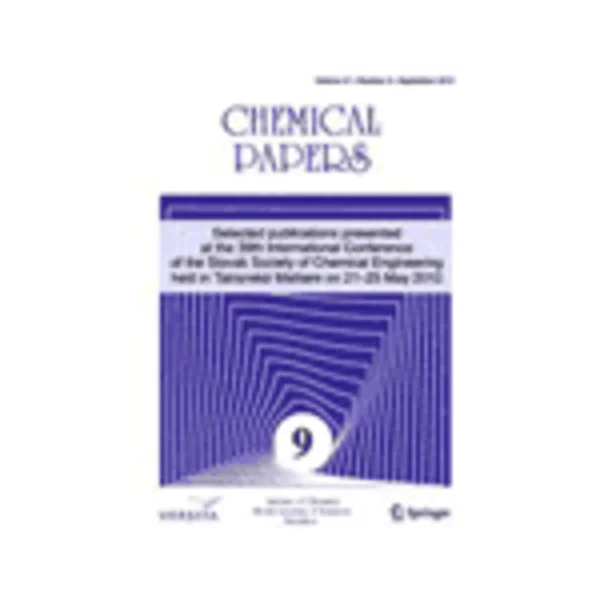-
determination of antioxidant activity using oxidative damage to plasmid dna — pursuit of solvent optimization
جزئیات بیشتر مقاله- تاریخ ارائه: 1392/07/24
- تاریخ انتشار در تی پی بین: 1392/07/24
- تعداد بازدید: 1084
- تعداد پرسش و پاسخ ها: 0
- شماره تماس دبیرخانه رویداد: -
oxidative stress plays a key role in the pathophysiology of many diseases. hydroxyl radical is the oxidative species most commonly causing damage to cells. the aim of this work was to optimize the method for antioxidant activity determination on a model lipophilic geranylated flavanone, diplacone. this method uses protection of plasmid dna from oxidation by a hydroxyl radical generated by the fenton reaction involving oxidation of metal ions using h2o2 and ascorbate. the method was optimized for lipophilic compounds using several solvents and co-solvents. it was found that (2-hydroxypropyl)-β-cyclodextrin (0.1 mass % aq. sol.) is the best co-solvent for our model lipophilic compound to measure the antioxidant activity by the method presented. other solvents, namely dimethyl sulfoxide, cremophor el® (0.1 mass % aq. sol.), ethanol, and methanol, were not suitable for the determination of the antioxidant activity by the method described. tween 80 (0.1 mass % aq. sol.) and a mixture of 10 vol. % ethanol and 9 mass % bovine serum albumin (aq. sol.) significantly decreased the antioxidant activity of the model lipophilic compound and thus were not suitable for this method.
مقالات جدیدترین رویدادها
-
استفاده از تحلیل اهمیت-عملکرد در ارائه الگوی مدیریت خلاقیت سازمانی و ارائه راهکار جهت بهبود
-
بررسی تاثیر ارزش وجوه نقد مازاد بر ساختار سرمایه شرکت های پذیرفته شده در بورس اوراق بهادار تهران
-
بررسی تأثیر سطح افشای ریسک بر قرارداد بدهی شرکت های پذیرفته شده در بورس اوراق بهادار تهران
-
بررسی تأثیر رتبه بندی اعتباری مبتنی بر مدل امتیاز بازار نوظهور بر نقد شوندگی سهام با تأکید بر خصوصی سازی شرکت ها
-
تأثیر آمیخته بازاریابی پوشاک ایرانی بر تصویر ذهنی مشتری پوشاک ایرانی (هاکوپیان)
-
بررسی تاثیر ابعاد قطعات بتنی در تعیین سرعت امواج فراصوتی و تاثیرآن در تخمین مقاومت فشاری بتن سخت شده
-
تحلیل حدی کران بالا ظرفیت بیرون کشیدکی لرزه ای مهار نواری افقی بر مبنای روش شبه دینامیکی
-
بهینه سازی هزینه و زمان در پروژه های ساخت
-
بررسی کمی و کیفی گونه جنگل کاری شده گز (.tamarix aphylla l) در حاشیه دریاچه ارومیه (مطالعه موردی: جبل کندی ارومیه)
-
مقایسه شتاب نگاشت های مقیاس شده و مصنوعی بر اساس طیف لرزه ای طراحی آیین نامه 2800
مقالات جدیدترین ژورنال ها
-
مدیریت و بررسی افسردگی دانش آموزان دختر مقطع متوسطه دوم در دروان کرونا در شهرستان دزفول
-
مدیریت و بررسی خرد سیاسی در اندیشه ی فردوسی در ادب ایران
-
واکاوی و مدیریت توصیفی قلمدان(جاکلیدی)ضریح در موزه آستان قدس رضوی
-
بررسی تاثیر خلاقیت، دانش و انگیزه کارکنان بر پیشنهادات نوآورانه کارکنان ( مورد مطالعه: هتل های 3 و 4 ستاره استان کرمان)
-
بررسی تاثیر کیفیت سیستم های اطلاعاتی بر تصمیم گیری موفق در شرکتهای تولیدی استان اصفهان (مورد مطالعه: مدیران شرکتهای تولیدی استان اصفهان)
-
تأثیر آموزش مهارت خودافشایی بر کاهش افسردگی دانش آموزان دختر مقطع متوسطه اول
-
مداخله ی آموزشی مبتنی بر مذهب بر نشانگان افسردگی زنان متاهل مراجعه کننده به مراکز فرهنگی شهر بابل
-
بررسی اثر دارویی استویا (stevia rebaudiana) در کنترل دیابت نوع دوم
-
بهره گیری از تکنیک خوشه بندی در ارتقای کارایی مدیریت ریسک در شرکتهای بیمه
-
evaluation the moisture susceptibility of asphalt mixtures containing demolished concrete waste materials




سوال خود را در مورد این مقاله مطرح نمایید :